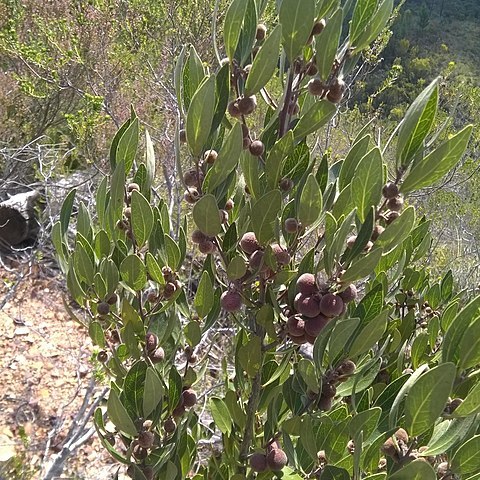Evergreen shrublets about 30 cm high or shrubs 0.6-2.5 m high, bark dark brown; branchlets somewhat virgate, densely ferruginous-pubescent, rather spreading and often lax. Leaves alternate or subopposite, discolorous to concolorous, pale olive green when mature, thickly coriaceous and stiff, shortly petioled, young leaves deep rusty-pubescent, becoming grey-pubescent, sometimes quite glabrous, narrowly to broadly elliptic, ovate or occasionally a few leaves oblong-rotundate or oblanceolate-elliptic, 2-6 cm long and 0.5-4.5 cm wide, base subcordate to acute; apex rounded to acute; nerves on older leaves raised on both surfaces but less so on the upper surface; margin thickened, flat, entire; petioles short, 2-7 cm long, usually pubescent; stipules absent. Inflorescence axillary 3-5 cm long, densely ferruginous-villous, 3-5-flowered, bracts small, lanceolate-boat shaped, villous; female inflorescence shorter and more compact than the male. Flowers dioecious, white, sweetly scented. Male flowers 5-6 mm long. Calyx widely campanulate, to half the length of the corolla, densely ferruginous-villous on outside, 5-7-lobed, lobes divided half or more than halfway down, deltoid to narrowly oblong-lanceolate. Corolla globose-truncate or urceolate, 4-5 mm long, sparsely to densely strigose-hirsute on outside, especially on the lobes; lobes very short or practically absent. Stamens 16-30, more or less united at the base, in two rows; filaments glabrous, flat, up to 1 mm long; anthers more or less oblong, 1.5-2 mm long, sparsely to densely hairy especially towards the apex. Ovary rudimentary, densely hirsute, with 2 fairly slender flattish styles. Female flowers calyx and corolla like those of the males. Staminodes absent. Ovary subglobose, densely hirsute, 4-6-celled with a single pendulous ovule in each cell; styles 2-3, usually hairy; stigmas oblique, crescent-shaped. Fruit a fleshy berry, depressed-globose to globose and somewhat beaked, densely ferruginous-hirsute, becoming red when ripe, usually with only one seed. Seeds globose, 5 mm in diam., divided into three parts by two thin lines and a groove; endosperm flinty, pale grey, somewhat ruminate.
More
Evergreen shrub or dwarf shrub, 0.3-2.5 m high; branchlets densely ferruginous-pubescent. Leaves alternate or subopposite, petiolate, pale olive-green, young leaves rusty-pubescent becoming grey-pubescent, elliptic or ovate, margins flat, thickened, entire. Inflorescence axillary, 30-50 mm long, 3-5-flowered, ferruginous-villous, female inflorescence shorter and more compact than male. Flowers sweetly scented, white. Fruit a fleshy berry, globose, somewhat beaked, ferruginous-hirsute, red when ripe. Seeds globose, 5 mm in diam.
A shrub. It grows 1-2 m tall. It is smaller in mountains. The branches spread at 40-60° angle. The leaves are alternate to almost opposite. They are oval and 3-8 cm long by 1-4 cm wide. Male and female flowers are separate. The fruit usually occur singly. They are 0.5-1 cm across. There is one seed.
Dioecious shrub to 2.5 m, rusty velvety on young parts. Leaves elliptic to ovate, leathery, usually grey-hairy. Flowers in rusty velvety, axillary racemes, hairy, shallowly lobed, white, fragrant, ovary hairy.

